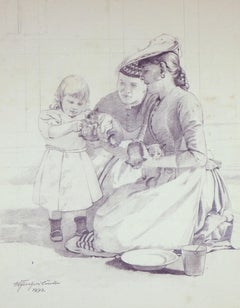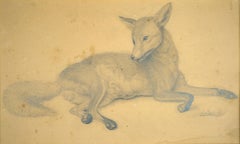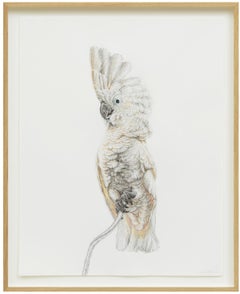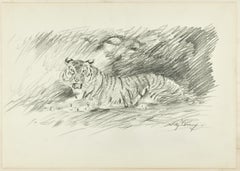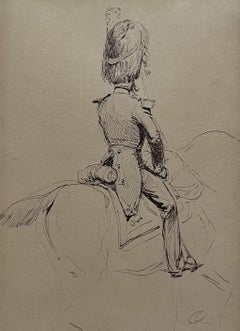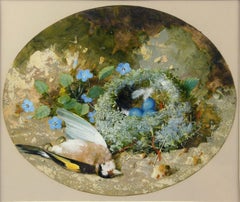Berlin - Animal Drawings and Watercolors
to
2
2
1
Overall Width
to
Overall Height
to
2
1
2
1
2
1
1
1
1
1
1
1
2
1
1
1
1
1,581
766
Item Ships From: Berlin
Feeding the Kittens - Little cat mother -
Located in Berlin, DE
Ernst Albert Fischer-Cörlin (1853 Körlin - 1932 Persante). Feeding the Kittens, 1893. Pencil on painting cardboard, 38 x 29 cm. Signed and dated by the artist at lower left "E[rnst] A[lbert] Fischer=Cörlin 1893".
- Lightly stained, somewhat dusty and minimally foxed.
- Little cat mother -
About the artwork
Daughter, mother and grandmother gather in the sunlight to feed a litter of kittens. The mother and grandmother hold the lively, playful animals in their arms, while the young girl feeds two of the four kittens with cookies. There is also a small bucket of milk and a bowl of milk. The women and the girl watch as the cute, still blind animals eat.
It is a scene taken from everyday life, but it also has an allegorical dimension, bringing maternal care into the representation. Three generations are represented, with the grandmother and the mother already mothers. They not only offer the kittens to the youngest, but also proudly observe the maternal care that the youngest gives to the kittens. Like the kittens, she will grow up and become a mother herself, so the image is also an allegory of life's ever-new beginnings. In keeping with this, the morning sun shines into the picture from the right. Fischer-Cörlin has masterfully worked out the quality of the light, with its light and dark areas, with the pencil used...
Category
1890s Academic Berlin - Animal Drawings and Watercolors
Materials
Cardboard, Carbon Pencil
$358 Sale Price
20% Off
Vigilant Fox - The psyche of the fox -
Located in Berlin, DE
Carl Friedrich Deiker (1838 Wetzlar - 1892 Düsseldorf). Vigilant fox. Pencil drawing on brown paper, 18 × 29.5 cm (inside measurement), 31.5 x 43.5 cm (mount), signed and dated "Deiker [18]54" at lower right.
- a little bit stained, with a light water stain at lower right
About the artwork
Carl Friedrich Deiker's consummate ability to depict animals is already evident in this early work. He brought a whole new psychological dimension to animal painting, so that one could literally speak of animal portraits.
The naturalistic appearance of the fox alone makes it seem alive. Every strand of muscle, even every hair, is captured, which requires an intensive artistic study of animal anatomy and physiology. But the fox's real liveliness comes not from its natural appearance, but from its internal movement: Stretched out, it has been brought out of rest. It turns around and, with its ears pricked up, looks intently in the direction from which it has seen something. His mouth is slightly open and his pointed teeth are bared, as if he were growling. Tension gradually takes hold of his whole body. While the hind legs were still in a relaxed position, closely observed by Deiker, one front leg was already raised, ready to begin a rising movement. The fox seems so alarmed with all its senses that one gets the impression that, at any moment, its tail will move jerkily and the animal will jump up.
While wild animals have traditionally been portrayed as beasts or anthropomorphised, often for caricatural purposes, Deiker explores their inherent nature by attempting to capture their psychic impulses. The wild animal is neither bestial nor human, but a creature in its own right, valued by Deiker for its own sake. In this way, he brought the dignity of the animal into representation and raised animal painting to a whole new artistic level.
About the artist
Carl Friedrich Deiker was the son of the drawing teacher Christian Friedrich Deiker and the younger brother of the animal painter Johannes Deiker. In addition to the family art lessons, Christian Friedrich shared a studio with his brother Johannes at Braunfels Castle, Deiker attended the drawing academy in Hanau, and from 1858 he was a student at the Karlsruhe Art Academy, where he studied under the landscape painter Johann Wilhelm Schirmer. Carl Friedrich Deiker was already in demand as an artist during his first year: Grand Duke Frederick I of Baden, Margrave Max of Baden and Grand Duke Michael of Russia bought hunting scenes by him.
In 1859 he went on a study trip to the Reinhardswald. Just as the Barbizon School had rediscovered the landscape, Deiker opened up the forest for animal painting.
From 1861-64 Deiker had his own studio in Karlsruhe, then moved to Düsseldorf, where his brother Johannes followed four years later. Deiker married a daughter of the landscape painter Karl Hilger and remained in Düsseldorf until his death.
In 1868 he finally achieved international fame with his painting 'Pursued Noble Deer' and was regarded as a virtuoso new founder of animal painting.
"Deiker brought for the first time a truly great artistic quality to animal painting [...]".
- Hans Vollmer
From 1870 he participated in the academic art exhibitions in Berlin, Dresden, Munich and Hanover. He was also very busy as an illustrator. He drew for the Gartenlaube, the Salon, the Universum, and produced many of the finely illustrated hunting and animal books of the period. He also worked as a printmaker, while his oil paintings circulated as reprints by Franz Dinger.
From 1865 to 1892 Deiker was a member of the artists' association Malkasten.
Carl Friedrich Deiker's life's work was honoured with a large posthumous memorial exhibition at the Düsseldorf Kunsthalle in 1892.
His son Carl Deiker, born in 1879, also became a painter.
Selection of art museums that own works by Carl Friedrich Deiker:
Hamburger Kunsthalle / Kunsthalle Karlsruhe / Kunstmuseum Düsseldorf / Wallraff Richartz Cologne.
Selected Bibliography
H. Schmidt: Johannes and...
Category
1850s Naturalistic Berlin - Animal Drawings and Watercolors
Materials
Pencil
$1,322 Sale Price
20% Off
Schrödingers Bird 14
Located in Berlin, DE
Signed and dated 'S. Schüffler 2021' lower right. From the series 'An Experiment on a Bird'. On white Mi-Teintes paper, Canson.
Category
21st Century and Contemporary Berlin - Animal Drawings and Watercolors
Materials
Chalk, Pastel
Related Items
Roaring Tiger - Original Pencil Drawing by Willy Lorenz - 1940s
By Wilhelm Lorenz
Located in Roma, IT
Roaring Tiger is a beautiful pencil original drawing on ivory-colored paper, realized in 1940s by the German artist Wilhelm Lorenz, best know as Willi Lorenz. Signed in pencil on lower right margin.
This is a wonderful study representing a crouched tiger roaring, realized with a fat pencil and with the incredible freshness of line and realism. This modern artwork is in very good conditions, except for some minor pencil stains on lower margin.
This is a really perfect artwork for your sophisticated home able to give your furniture a touch of wildness and exotism.
Wilhelm (Willi) Lorenz (German, 1901–1981)
Wilhelm Lorenz that signed Willi Lorenz, was a German painter specialized in paintings of animals typically hunted as game. His highly detailed oil paintings evoke the texture and movement of animals like boars, foxes, bisons or lions depicted in their natural habitats and attitudes. His artworks bears...
Category
1940s Modern Berlin - Animal Drawings and Watercolors
Materials
Pencil
$648
H 11.62 in W 16.03 in D 0.04 in
Edouard Detaille (1848 1912) An officer of the Gendarmerie Impériale, drawing
By Jean Baptiste Édouard Detaille
Located in Paris, FR
Edouard Detaille (1848-1912)
An officer of the Gendarmerie Impériale, viewed of the back
bears the monogram ED but it is not visible because it is hidden by the mounting of the frame...
Category
1880s Academic Berlin - Animal Drawings and Watercolors
Materials
Ink
Bird - Drawing by Benn - 1970
Located in Roma, IT
Bird is a drawing in pastel on paper realized by Benn (Bencjon Rabinowicz) in 1970.
Hand signed on the lower, dated.
Good conditions.
Benn (Bencj...
Category
1970s Modern Berlin - Animal Drawings and Watercolors
Materials
Pastel
French School 19th Century, Studies of horses, two drawings
Located in Paris, FR
French School 19th Century,
Studies of horses,
two drawings in the same frame
7 x 11 cm (oval) and 7 x 9.8 cm
pencil on paper
Condition : The oval one on the left with foxings (see...
Category
1880s Academic Berlin - Animal Drawings and Watercolors
Materials
Pencil
The Fish - Pencil on Paper by J. P. Verdussen - 1775 ca.
By Jan Peeter Verdussen
Located in Roma, IT
The Fish is a beautiful drawing in pencil on paper realized by Jan Peter Verdussen in 1755 ca.
Hand-signed and dated on the lower in pencil.
In good condition, and aged.
The artwo...
Category
1770s Modern Berlin - Animal Drawings and Watercolors
Materials
Pencil
$1,060
H 7.49 in W 10.24 in D 0.04 in
WPA Post Office Mural Study American Scene Regionalism Social Realism
By Louise Ronnebeck
Located in New York, NY
WPA Post Office Mural Study American Scene Regionalism Social Realism
Louise Emerson Ronnebeck (1901 - 1980)
Oil Riggers, Mural Study
Image: 6 1/2 x 37 inches
Watercolor and egg tem...
Category
1930s American Modern Berlin - Animal Drawings and Watercolors
Materials
Paper, Watercolor, Cardboard
Horse with Herds - China Ink Drawing by Filippo Palizzi - 1895
By Filippo Palizzi
Located in Roma, IT
Image dimensions: 14x22 cm.
Horse with Herds is a really beautiful china ink original drawing on paper, signed and dated in black ink on lower margin by the Italian artist, Filippo Palizzi...
Category
1890s Naturalistic Berlin - Animal Drawings and Watercolors
Materials
Ink
$1,414
H 12.21 in W 15.28 in D 0.67 in
Horses - Pencil Drawing - Mid-20th Century
Located in Roma, IT
Horses is a pencil drawing on ivory-colorated paper, realized by unknown Artist of Mid-20th Century.
In very good conditions.
Not signed.
Illegible signature on the back of the dr...
Category
Mid-20th Century Modern Berlin - Animal Drawings and Watercolors
Materials
Pencil
People and Animals - Drawing in Pencil on Paper - 19th Century
Located in Roma, IT
People and Animals is an original drawing in pencil on paper, realized by an Anonymous artist of the XIX century. With a drawing of a cat and its kitt...
Category
19th Century Modern Berlin - Animal Drawings and Watercolors
Materials
Pencil
$330
H 11.82 in W 18.12 in D 0.04 in
Siren - Contemporary Art, Nude, Female, Nature, White, Blue, Gray, Flowers
By Alexandru Rădvan
Located in Baden-Baden, DE
Siren, 2015
Collage on cardboard
27 9/16 H x 39 3/8 W in.
70 H x 100 W cm
The artist's reference on fundamental myths of humanity and their analysis from the perspective of contempo...
Category
2010s Contemporary Berlin - Animal Drawings and Watercolors
Materials
Paper, Acrylic, Cardboard
$1,414
H 31.5 in W 43.31 in D 3.15 in
WPA Post Office Mural Study Native American Scene Regionalism Social Realism
By Louise Ronnebeck
Located in New York, NY
WPA Post Office Mural Study Native American Scene Regionalism Social Realism
Louise Emerson Ronnebeck (1901 - 1980)
Proposal Sketch for Worland Wyoming Post Office WPA Mural Project
Image: 7 x 15 inches
Board 14 x 22 inches
Watercolor on paper, attached to black/gray cardboard/thick paper
c. 1937
Signed lower right
Written in Louise's hand on mounting paper in white chalk/pencil: "Sketch for Mural...
Category
1930s American Realist Berlin - Animal Drawings and Watercolors
Materials
Paper, Watercolor, Cardboard
Red Goat Abstract Collage
By Karen Druker
Located in Soquel, CA
Figurative abstract collage with goats and other media layered to form an interesting visual texture by Karen Druker (American, 1945). Signed "Druker" in the lower right corner. Pres...
Category
21st Century and Contemporary Contemporary Berlin - Animal Drawings and Watercolors
Materials
Paper, Pastel, Mixed Media, Acrylic, Cardboard, Pen
Previously Available Items
Still life with dead goldfinch - The mystic blue transcends death -
Located in Berlin, DE
William Cruickshank (1848-1922). Still Life with a Dead Goldfinch and Nest. Watercolour and gouache on buff paper, 21 x 24.5 cm (visible size), 40 x 42 cm (frame), signed W Cruickshank on the left. Framed behind glass in a passpartout.
About the artwork
The painting has an atmosphere of melancholy beauty. The clutch of eggs, recalling the wonderfully mysterious blue of Romanticism, the matching blue flowers and the goldfinch with its black, yellow and red plumage show nature in all its beauty, and yet the goldfinch is dead. It lies on its back, its head bent backwards in an unnatural way, its claws lifeless and one wing outstretched in a last effort. This makes the scene a natura morta, a still life that spreads the melancholy silence of an eternal moment. Yet there is also an inherent movement in the picture, enhanced by the streaky application of paint.
A movement that here signifies the intertwining of life and death: death, which the goldfinch has met in mid-life, before it has been able to hatch its offspring, while at the same time the mysterious blue eggs that have not hatched point to a higher life after death. Finally, the goldfinch feeding on the thorny thistles traditionally represents Christ and his redemptive sacrificial death. The goldfinch is depicted in a similar way in Carel Fabritius' famous painting The Thistle Finch (1654), in the Mauritshuis in The Hague. The bird is alive, but chained and thus prevented from flying.
In this tradition, Cruickshanks' painting is a memento mori that is immediately appealing to today's viewer - a meditative image of life and death that also contains an affirmation of life in all the beauty of creation. In order to enhance the readability of this pictorial sense, the objects depicted are tilted into the plane so that the individual elements of the picture can be more easily related to one another, but without destroying the sense of space.
Cruickshank, who specialised in this type of painting, combined the emblematics of the Baroque with the imagery of Romanticism and a style borrowed from landscape painting. Cruickshank's mastery of materials is evident in his fusion of watercolour and gouache, in which the more intense colours of gouache concretise the motif from an indeterminate, moving colour space. The painted objects have the aesthetic quality of fine painting, although, as in the case of the nest, they are formed by a virtuoso structure of blotches.
Selected bibliography
Algernon Graves: The Royal Academy of Arts. A complete dictionary of contributors and their work from its foundation in 1769 to 1904, vol. 2: Carroll to Dyer, London 1905.
Leo R. Schidlof: The miniature in Europe. In the 16th, 17th, 18th, and 19th centuries, vol. 1: A - L, Graz 1964.
Jeremy Maas: Victorian painters, London 1996.
Daphne Foskett: A Dictionary of British miniature...
Category
1890s English School Berlin - Animal Drawings and Watercolors
Materials
Watercolor, Gouache
